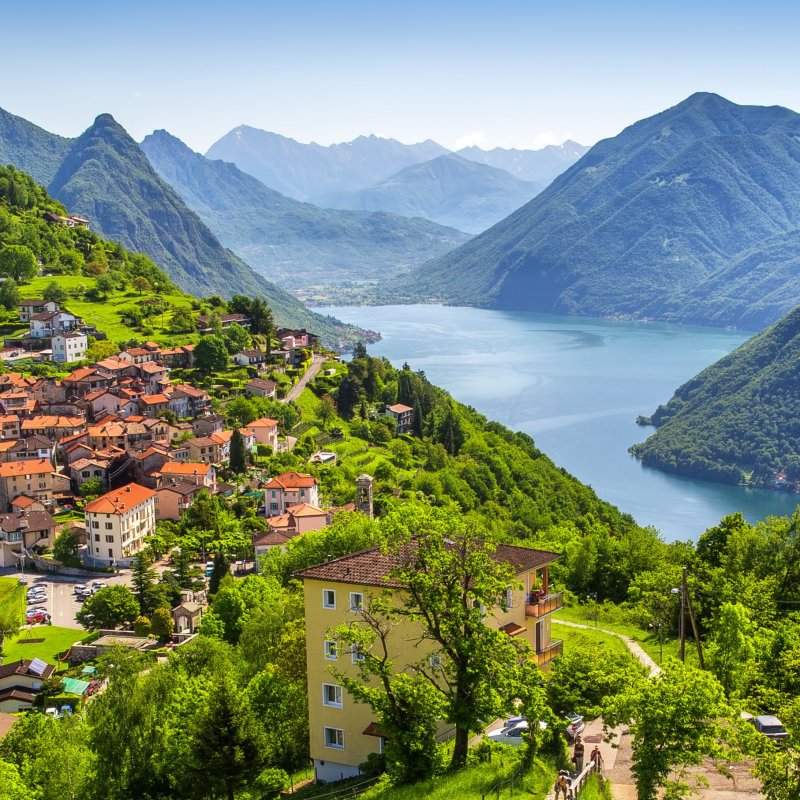
Note: The Travel Awaits team regularly updates content to provide the latest, and most accurate information to our readers. The updated content in this article may not reflect the views or opinions of the original author.
Videos by TravelAwaits
You may say: But Switzerland is landlocked! How can there be a Mediterranean region? You are correct in theory, but we are taking you to Ticino, Switzerland’s southernmost canton. Sometimes a place is not defined by its location but more so by its atmosphere and flair. In that respect, Ticino canton definitely feels Mediterranean, as you will see when we take you to all the gorgeous places.
Ticino (Tessin) is surrounded on three sides by Italy, and it also comprises the Italian enclave of Campione d’Italia. The official language is Italian.
With a much milder climate than the rest of Switzerland and an average of 2,300 hours of sunshine annually, it definitely feels southern. In addition, although there are plenty of woods, palm trees are growing everywhere; in fact, they are taking over parts of the woods. Visit Lugano, Ticino’s largest city, and the colorful houses, sub-tropical flora, and language will make you think you are indeed in a Mediterranean region.
Canton Ticino is home to three UNESCO World Heritage sites, the Bellinzona and Monte Giorgio castles, two fabulous lakes, the river Ticino, and a curiosity called the Swissminiatur. As the name indicates, it’s an amusement park of 123 miniature buildings and landscapes, representing all important parts of Switzerland.
The biggest airport in canton Ticino is in Locarno, where trains and buses take you to any destination within the canton and beyond.

8 Gorgeous Places To Visit In Ticino, Switzerland
1. Ascona
The charming village of Ascona is located on the northern shore of Lake Maggiore. It is Switzerland’s lowest lying town, only a few feet above sea level. Ascona is a popular resort famous for its love of beauty and attention to service. First, make your way to the old Town, called Borgo, and visit the 16th-century Santi Pietro e Paolo church. The high bell tower is Ascona’s best-known landmark.
Then stroll along the beautiful, car-free promenade on the shore of Lake Maggiore. Browse in the many fashion boutiques, pop into some of the art galleries and, of course, have a coffee, cake, and ice cream break in one of the many cafes and just watch the world go by.
Every Tuesday, all day long, there is a market. The many stalls sell just about everything, from sweets, wine, and spirits, to clothes, shoes, hats, and wooden carvings made by local craftsmen. It’s truly a treasure trove for souvenirs.
Above the town rises Monte Verita, or mountain of truth. At the beginning of the 20th century, people with a penchant for philosophy formed an early hippie colony there. Today, the universities of Lucerne and Zurich hold seminars there. Make your way up and visit the museum, which documents the colony’s history and its founders.

2. Bellinzona
Located east of the river Ticino and spread along the river valley at the foot of the Alps, Bellinzona is Ticino’s capital. History fans will thrive in Bellinzona because of the medieval heritage, most famously the city wall and the three castles, which are all parts of a UNESCO World Heritage Site. They are Castlegrande, Montebello, and Sasso Corbaro. All three castles have undergone ample restorations and are today open to the public in their former glory. Take your time to explore them all and also walk along the ancient city wall. Bellinzona’s history is closely connected to the Dukes of Milan, and you will find many influences.
For some more history, visit the Museum Villa dei Cedri. The museum is currently closed but will reopen on March 19th with a special exhibition.
Bellinzona is an important stop on the Gotthard Railway. Therefore, it’s easy to reach by train.

3. Locarno
Located on the shore of Lake Maggiore, Locarno is the warmest town in Switzerland. Not surprisingly, it’s a popular summer destination where palm and lemon trees abound. Explore the Piazza Grande in the center of the old town, famous for an annual film festival. Admire the elegant upper town palazzi, stroll along the beautiful lake promenade and enjoy the Italian flair. Visit the impressive 12th-century Castello Visconteo, which has been restored nearly in its entirety.
Then make your way up to Orselina and pay your respects to the pilgrimage church of the sanctuary of Madonna del Sasso. Legend has it, the Virgin Mary made an appearance here, and it’s a famous landmark of Locarno. The views alone make the climb worthwhile.

4. Lugano
Lugano lies on the northern shore of glacial and wild Lake Lugano, surrounded by mountains, near Milan. The atmosphere of the city clearly shows the influence of nearby Lombardy in Italy. It’s a city that will enchant lovers of art and architecture. Just head for Piazza della Riforma in the center of town, which is ringed by pastel-colored, neoclassical palazzi, Baroque, and Renaissance churches and arcades. For some serious shopping, browse along Via Nassa, walk under the arcades, and enjoy the elegant boutiques and cafes.
Two mountains rise close to lake Lugano: San Salvatore and Mount Bre. Both, as well as the oblong and twisted lake, reflect wild nature. A cable car takes you up the mountain if you wish to explore the hiking trails. Boat tours are also available to sail around the lake and view the town from the water.
German author and Nobel Prize laureate Hermann Hesse fell so in love with Lugano that he remained here for 50 years until his death. Visit the Hesse Museum.
Another Lugano highlight of the arts is the Museo d’Arte della Svizzera Italiana (MASI), a unique art collection founded in 2015.

5. Lago Maggiore
The large lake in Ticino is shared by Switzerland and the Italian regions of Lombardy and Piedmont. The mild climate creates lush, Mediterranean vegetation like lemon and palm trees. Many beautiful towns and villages are dotted around the lake, as we have shown you above. The best way to explore the lake and shores is by going on a day trip with the Lago Maggiore Express, a boat and train combination.

6. Swissminiatur
A delight for adults and kids alike is Swissminiatur, Switzerland’s only open-air miniature park. Located in Melida, close to Lugano on the shores of the lake of the same name and surrounded by majestic mountains, you can wander around Switzerland’s most important sights and landmarks at your leisure.

7. Tibetan Bridge Of Curzutt
A truly breathtaking adventure is walking the Tibetan Hanging Bridge of Curzutt. The trail begins through vineyards and chestnut woods in the Magadine plain with views of Lago Maggiore until you reach the bridge, which is suspended 426 feet above the creek below. Never fear; safety mesh wire on the sides and handrails make the crossing pretty safe.
After that, the trail leads to the Romanesque Church of San Bernardo and on to the settlement of Curzutt, a cluster of ancient stone houses, gardens, and fields at an altitude of nearly 2,000 feet.

8. Verzasca River And Dam
Another unforgettable nature adventure is the Verzasca Valley Trail. Verzasca is a river in Ticino which originates in Pizzo Barone and flows into the Great Lake. The winding river is known for its turquoise water and colored rocks. It leads through woods and villages such as Corripo, Laverteaz, or Sonogno. At the end sits the Verzasca Dam, popular for bungee jumping, an activity you might want to pass on. Instead, visit the pretty hamlet of Sonogno with its tiny museum and ancient communal oven that is still in use today. Ancient tradition comes to life in the Casa della Lana, where wool is carded and dyed in age-old fashion.
Pro Tips
Don’t worry if you don’t speak Italian. Ticino is a very popular destination for visitors from all nationalities, meaning that at least some English will be understood everywhere. The Italian influence is also noticeable as people in Ticino tend to hold a siesta, something you won’t find in Zurich or Bern. Generally, shops are open from 8 or 9 a.m. to 7 p.m., although a few might close an hour or two at lunchtime.
Final Thoughts on Gorgeous Places To Visit In Ticino
With its captivating blend of Swiss Alps splendor and Mediterranean charm, Ticino is a destination that attracts travelers from all corners of the world. From the serene shores of Lake Maggiore to the busy streets of Lugano, every part of this region tells a story of tradition, nature, and culture.
As you walk through its stone villages, eat in lakeside cafes, or enjoy the panoramic views, you’ll realize that Ticino is not just a place on the map. When it comes to food, Ticino is an Italian-speaking region and Italy obviously had a big influence on the typical food. Polenta, minestrone, and risotto with olive oil and many more dishes are served in restaurants.
Overall, Ticino is a symphony of experiences, a tapestry of memories waiting to be woven.
Whether you’re looking for outdoor adventure or a tranquil escape, Ticino promises an enchanting journey. From the romantic Ascona to the natural beauty of Verzasca Valley, there are plenty of exciting places to go to. The unique culture, cuisine, and atmosphere make it a wonderful place for a getaway. So pack your bags, bring your camera, and discover the amazing sites that are just begging to be photographed.
Other popular places to visit in Ticino are Montebello Castle, Monte San Giorgio Mountain, and Verzasca Valley.
If you’re looking for outdoor adventure or cozy cafés, try to take in each moment with gratitude and soak up every bit of Ticino’s beauty. Who knows? Maybe you’ll leave with some incredible new memories. Happy exploring!
FAQs
Are There Any Family-Friendly Attractions in Ticino?
Certainly! This beautiful region is perfect for families, with plenty of activities to keep children entertained. Apart from the natural attractions, adventure parks are scattered across the region and families can enjoy places like Swissminiatur, a miniature park showcasing Switzerland’s iconic landmarks.
Can You Speak Other Languages In Ticino Apart From Italian?
Yes, you can get around with English or some basic German in many places like supermarkets, restaurants, and shops if you do not speak Italian. Of course, it is always good to know a bit of Italian, so we suggest learning at least a few basic phrases.
What Is the Currency In Ticino?
The local currency used in Ticino is the Swiss Franc (CHF), but you can also use Euros (EUR) in quite a few locations since Ticino is so close to the Italian border.
In addition, debit and credit cards are widely accepted everywhere.
What Is a Ticino Ticket?
Ticino ticket is a great way to get free and unlimited use of public transportation during your entire stay in Ticino. As soon as you check in at a hotel, hostel, or campsite, you will receive the Ticino ticket included with your booking.
Is Ticino Expensive?
Yes! Switzerland is quite expensive, but you get quality in return. However, most activities in nature are completely free of charge, so you can spend more money on delicious meals and wine. You can easily budget your trip that way and still manage to have a blast.
